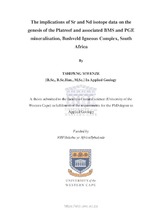| dc.description.abstract | The Platreef is a platinum group elements (PGE) deposit located in the Northern limb of the Bushveld Igneous Complex (BIC). It is a series of mafic and ultramafic sills that are overlain by rocks from the Main Zone (MZ) of the BIC. In comparison to PGE deposits (i.e., Merensky Reef and the UG-2 chromitite) occurring in the Critical Zone (CZ) of the Eastern and Western Limbs of the BIC, which are less than 1 m in thickness, the Platreef is 10 to 400 m in thickness and is comprised of a variety of rocks. PGE mineralisation in the Platreef is not confined to a specific rock type, and its distribution and styles also vary with depth and along strike. Despite the numerous researches that have been conducted, the genesis of Platreef is still poorly understood.
New major and trace elements in conjunction with Sr–Nd isotope data, generated from whole-rock analyses of different Platreef rocks, were collected from four drill cores along its strike. The data were examined to determine the source of the magmas and identify the processes involved in its genesis. The study also aimed at establishing whether a genetic link exists between the Platreef magmas and the magmas that formed the Lower Zone (LZ), CZ and MZ in the Rustenburg Layered Suite (RLS) of the BIC.
The petrography revealed that the Platreef in the four drill cores consists of harzburgite, olivine pyroxenite, pyroxenite, feldspathic pyroxenite and norite. Based on the textural and modal mineralogy variations, feldspathic pyroxenite was subdivided into five types (I, II, III, IV and V). The variation in the average contents of MgO, LaN/YbN and ΣREE for the Platreef rocks are consistent with the modal mineralogy from the least to the most differentiated rocks. However, the Sr–Nd isotope data of the Platreef rocks have revealed two distinct groups of samples with decreasing ɛNd2060. Group 1 consists of pyroxenite and feldspathic pyroxenite II, III and V having ɛNd2060 values that range from –8.4 to –2.9, and 87Sr/86Sr2060 values from 0.707281 to 0.712106. The Platreef rocks of group 2 consist of olivine pyroxenite and feldspathic pyroxenite Type I with ɛNd2060 ranging from –12.6 to –10.8, and 87Sr/86Sr2060 ranging from 0.707545 to 0.710042.
In comparison to the LZ, CZ and MZ rocks, which have ɛNd values ranging from –8.5 to –5.1, and 87Sr/86Sr ranging from 0.704400 to 0.709671, Platreef pyroxenite of group 1 have lower negative ɛNd2060 values (from –3.8 to –2.9) and higher 87Sr/86Sr2060 values from 0.709177 to 0.710492, whereas feldspathic pyroxenite of group 1 have overlapping ɛNd2060 values (from –8.4 to –4.9) but also higher 87Sr/86Sr2060 values (from 0.707281 to 0.712106). Instead, the Platreef olivine pyroxenite and feldspathic pyroxenite in group 2 highly negative ɛNd2060 values and overlapping 87Sr/86Sr2060 values.
It is therefore suggested that the Platreef magmas derived from the partial melting of an heterogeneous mantle source comprising depleted mantle melts and both metasomatized slightly unradiogenic Nd enriched melts and highly unradiogenic Nd enriched melts from the subcontinental lithospheric mantle. These magmas ascended via the continental crust using different paths and interacted with rocks of different Sr–Nd isotopic compositions which resulted in the formation the hybrid magmas. The study speculates that sulphide saturation in the Platreef magmas was reached in the staging chambers at depth, and the varying styles of the PGE mineralisation in the Platreef rocks are the result of the varying degree of partial melting of the heterogeneous source for their magmas.
In conlusion, this study suggests that the genesis of the Platreef is much more complex and should be considered very much independent from processes involved in the genesis of the RLS in the Eastern and Western Limbs of BIC in agreement with earlier studies. | en_US |

